Page 221 of 282

220
WARNING
LIGHTS AND
MESSAGES
INDEX
DASHBOARD
AND CONTROLS
SAFETY
DEVICES
CORRECT USE
OF THE
VEHICLE
IN AN
EMERGENCY
VEHICLE
MAINTENANCE
TECHNICAL
SPECIFICATIONS
UNDERSTANDING RIM
MARKING fig. 4
Example: 6J x 15 ET43
6,00 = rim width in inches 1.
J = rim drop centre outline (side
projection where the tyre bead
rests) 2.
15 = rim nominal diameter in inches
(corresponds to diameter of the
tyre to be mounted) 3= Ø.
ET43 = wheel camber angle (distance be-
tween the disc/rim supporting
plane and the wheel rim centre
line). Load rating (capacity)
70= 335 kg 81= 462 kg
71= 345 kg 82= 475 kg
72= 355 kg 83= 487 kg
73= 365 kg 84= 500 kg
74= 375 kg 85= 515 kg
75= 387 kg 86= 530 kg
76= 400 kg 87= 545 kg
77= 412 kg 88= 560 kg
78= 425 kg 89= 580 kg
79= 437 kg 90= 600 kg
80= 450 kg 91= 615 kg Maximum speed rating
Q= up to 160 km/h.
R= up to 170 km/h.
S= up to 180 km/h.
T= up to 190 km/h.
U= up to 200 km/h.
H= up to 210 km/h.
V= up to 240 km/h.
Maximum speed rating
for snow tyres
QM + S= up to 160 km/h.
TM + S= up to 190 km/h.
HM + S= up to 210 km/h.
Page 231 of 282
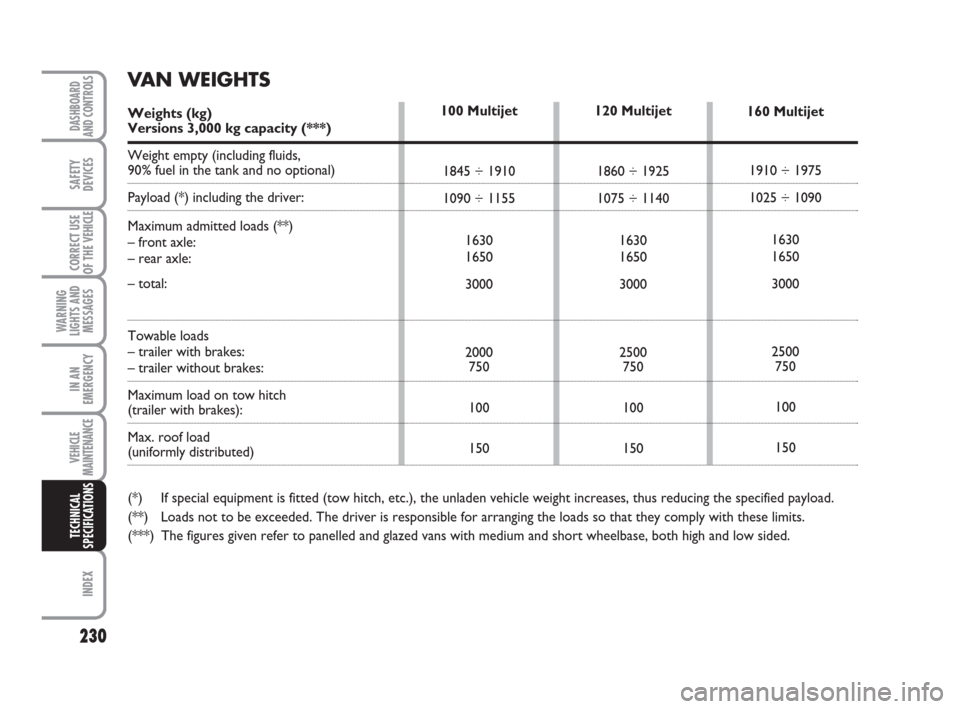
230
WARNING
LIGHTS AND
MESSAGES
INDEX
DASHBOARD
AND CONTROLS
SAFETY
DEVICES
CORRECT USE
OF THE
VEHICLE
IN AN
EMERGENCY
VEHICLE
MAINTENANCE
TECHNICAL
SPECIFICATIONS
120 Multijet
1860 ÷ 1925
1075 ÷ 1140
1630
1650
3000
2500
750
100
150160 Multijet
1910 ÷ 1975
1025 ÷ 1090
1630
1650
3000
2500
750
100
150 100 Multijet
1845 ÷ 1910
1090 ÷ 1155
1630
1650
3000
2000
750
100
150
VAN WEIGHTS
Weights (kg)Versions 3,000 kg capacity (***)
Weight empty (including fluids,
90% fuel in the tank and no optional)
Payload (*) including the driver:
Maximum admitted loads (**)
– front axle:
– rear axle:
– total:
Towable loads
– trailer with brakes:
– trailer without brakes:
Maximum load on tow hitch
(trailer with brakes):
Max. roof load
(uniformly distributed)
(*) If special equipment is fitted (tow hitch, etc.), the unladen vehicle weight increases, thus reducing the specified payload.
(**) Loads not to be exceeded. The driver is responsible for arranging the loads so that they comply with these limits.
(***) The figures given refer to panelled and glazed vans with medium and short wheelbase, both high and low sided.
Page 232 of 282
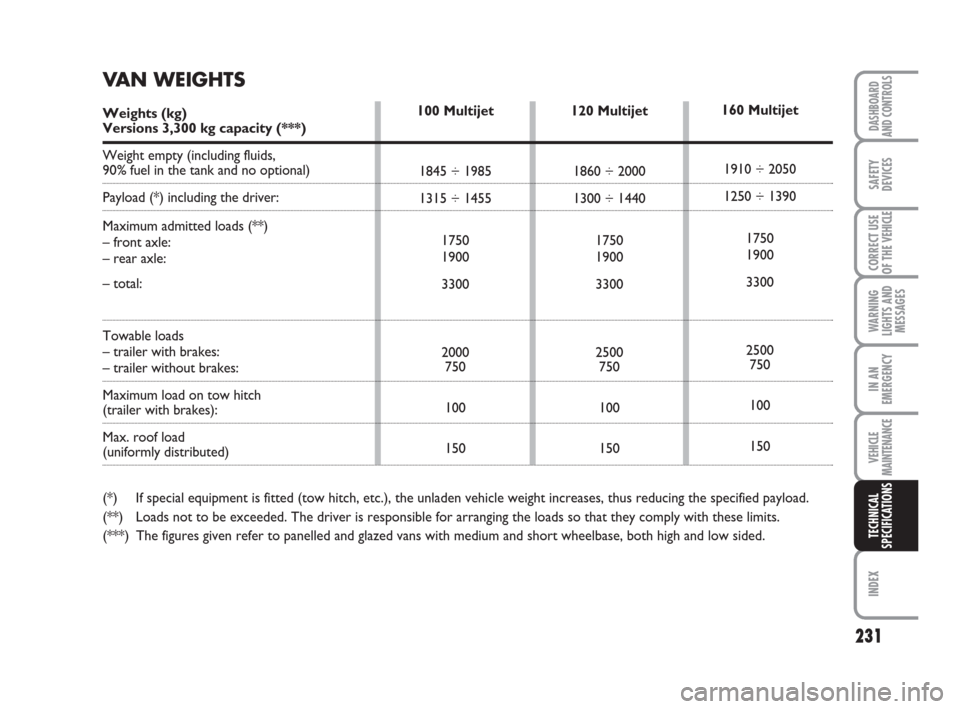
231
WARNING
LIGHTS AND
MESSAGES
INDEX
DASHBOARD
AND CONTROLS
SAFETY
DEVICES
CORRECT USE
OF THE
VEHICLE
IN AN
EMERGENCY
VEHICLE
MAINTENANCE
TECHNICAL
SPECIFICATIONS
120 Multijet
1860 ÷ 2000
1300 ÷ 1440
1750
1900
3300
2500
750
100
150160 Multijet
1910 ÷ 2050
1250 ÷ 1390
1750
1900
3300
2500
750
100
150 100 Multijet
1845 ÷ 1985
1315 ÷ 1455
1750
1900
3300
2000
750
100
150
VAN WEIGHTS
Weights (kg)Versions 3,300 kg capacity (***)
Weight empty (including fluids,
90% fuel in the tank and no optional)
Payload (*) including the driver:
Maximum admitted loads (**)
– front axle:
– rear axle:
– total:
Towable loads
– trailer with brakes:
– trailer without brakes:
Maximum load on tow hitch
(trailer with brakes):
Max. roof load
(uniformly distributed)
(*) If special equipment is fitted (tow hitch, etc.), the unladen vehicle weight increases, thus reducing the specified payload.
(**) Loads not to be exceeded. The driver is responsible for arranging the loads so that they comply with these limits.
(***) The figures given refer to panelled and glazed vans with medium and short wheelbase, both high and low sided.
Page 233 of 282
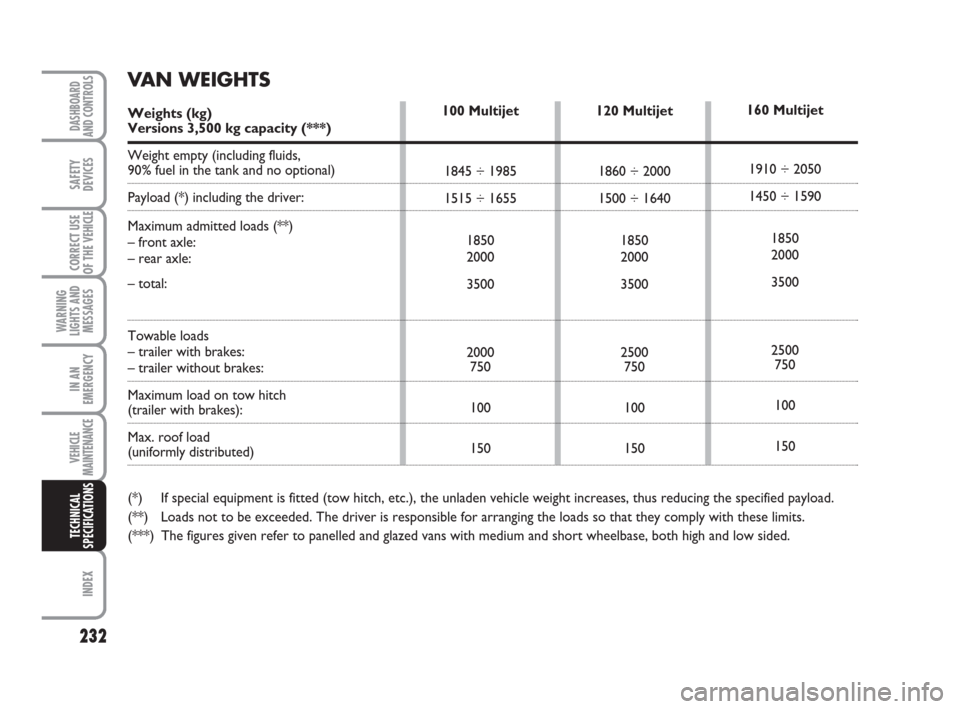
232
WARNING
LIGHTS AND
MESSAGES
INDEX
DASHBOARD
AND CONTROLS
SAFETY
DEVICES
CORRECT USE
OF THE
VEHICLE
IN AN
EMERGENCY
VEHICLE
MAINTENANCE
TECHNICAL
SPECIFICATIONS
120 Multijet
1860 ÷ 2000
1500 ÷ 1640
1850
2000
3500
2500
750
100
150160 Multijet
1910 ÷ 2050
1450 ÷ 1590
1850
2000
3500
2500
750
100
150 100 Multijet
1845 ÷ 1985
1515 ÷ 1655
1850
2000
3500
2000
750
100
150
VAN WEIGHTS
Weights (kg)Versions 3,500 kg capacity (***)
Weight empty (including fluids,
90% fuel in the tank and no optional)
Payload (*) including the driver:
Maximum admitted loads (**)
– front axle:
– rear axle:
– total:
Towable loads
– trailer with brakes:
– trailer without brakes:
Maximum load on tow hitch
(trailer with brakes):
Max. roof load
(uniformly distributed)
(*) If special equipment is fitted (tow hitch, etc.), the unladen vehicle weight increases, thus reducing the specified payload.
(**) Loads not to be exceeded. The driver is responsible for arranging the loads so that they comply with these limits.
(***) The figures given refer to panelled and glazed vans with medium and short wheelbase, both high and low sided.
Page 234 of 282
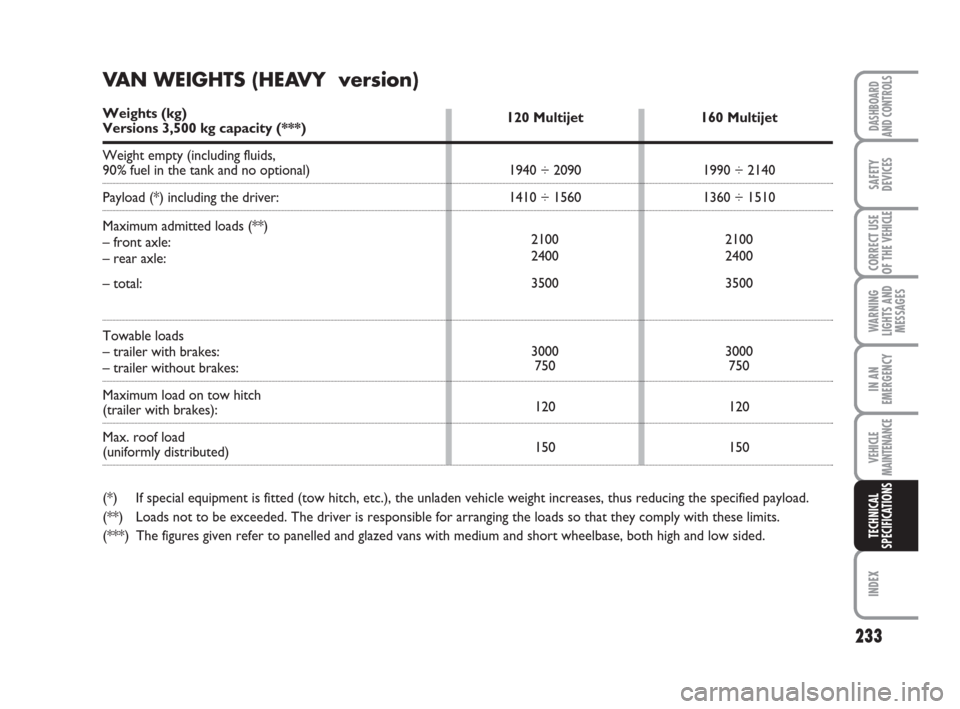
233
WARNING
LIGHTS AND
MESSAGES
INDEX
DASHBOARD
AND CONTROLS
SAFETY
DEVICES
CORRECT USE
OF THE
VEHICLE
IN AN
EMERGENCY
VEHICLE
MAINTENANCE
TECHNICAL
SPECIFICATIONS
120 Multijet
1940 ÷ 2090
1410 ÷ 1560
2100
2400
3500
3000
750
120
150160 Multijet
1990 ÷ 2140
1360 ÷ 1510
2100
2400
3500
3000
750
120
150
VAN WEIGHTS (HEAVY version)
Weights (kg)Versions 3,500 kg capacity (***)
Weight empty (including fluids,
90% fuel in the tank and no optional)
Payload (*) including the driver:
Maximum admitted loads (**)
– front axle:
– rear axle:
– total:
Towable loads
– trailer with brakes:
– trailer without brakes:
Maximum load on tow hitch
(trailer with brakes):
Max. roof load
(uniformly distributed)
(*) If special equipment is fitted (tow hitch, etc.), the unladen vehicle weight increases, thus reducing the specified payload.
(**) Loads not to be exceeded. The driver is responsible for arranging the loads so that they comply with these limits.
(***) The figures given refer to panelled and glazed vans with medium and short wheelbase, both high and low sided.
Page 235 of 282
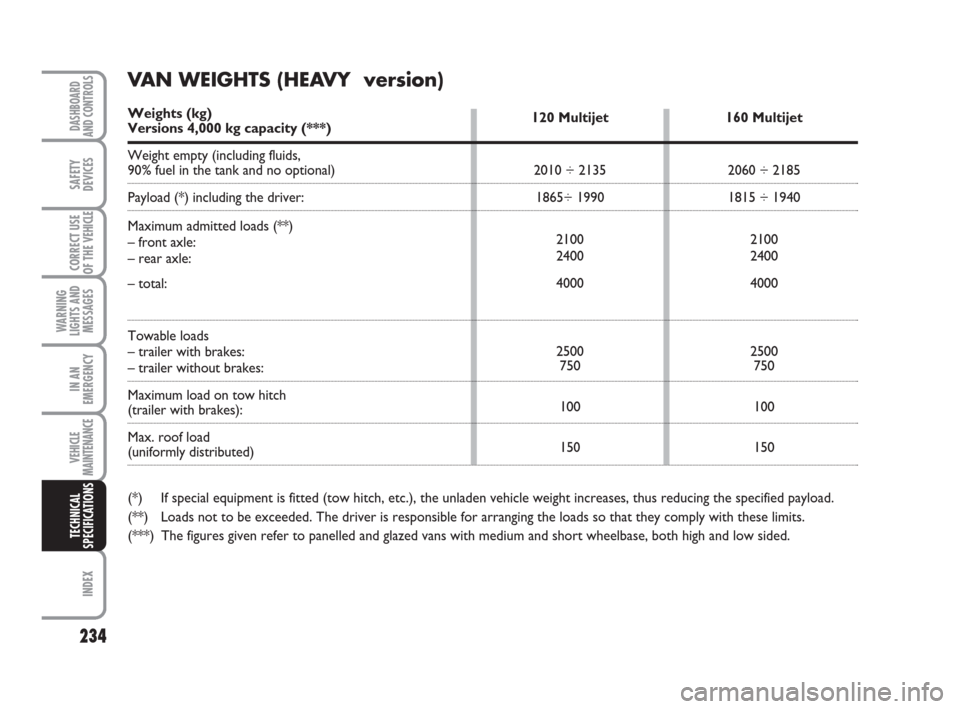
234
WARNING
LIGHTS AND
MESSAGES
INDEX
DASHBOARD
AND CONTROLS
SAFETY
DEVICES
CORRECT USE
OF THE
VEHICLE
IN AN
EMERGENCY
VEHICLE
MAINTENANCE
TECHNICAL
SPECIFICATIONS
120 Multijet
2010 ÷ 2135
1865÷ 1990
2100
2400
4000
2500
750
100
150160 Multijet
2060 ÷ 2185
1815 ÷ 1940
2100
2400
4000
2500
750
100
150
VAN WEIGHTS (HEAVY version)
Weights (kg)Versions 4,000 kg capacity (***)
Weight empty (including fluids,
90% fuel in the tank and no optional)
Payload (*) including the driver:
Maximum admitted loads (**)
– front axle:
– rear axle:
– total:
Towable loads
– trailer with brakes:
– trailer without brakes:
Maximum load on tow hitch
(trailer with brakes):
Max. roof load
(uniformly distributed)
(*) If special equipment is fitted (tow hitch, etc.), the unladen vehicle weight increases, thus reducing the specified payload.
(**) Loads not to be exceeded. The driver is responsible for arranging the loads so that they comply with these limits.
(***) The figures given refer to panelled and glazed vans with medium and short wheelbase, both high and low sided.
Page 236 of 282
235
WARNING
LIGHTS AND
MESSAGES
INDEX
DASHBOARD
AND CONTROLS
SAFETY
DEVICES
CORRECT USE
OF THE
VEHICLE
IN AN
EMERGENCY
VEHICLE
MAINTENANCE
TECHNICAL
SPECIFICATIONS
120 Multijet
1810 ÷ 1855
1125 ÷ 1145
1630
1650
2935/3000
2500
750
100160 Multijet
1860 ÷ 1905
1095 ÷ 1140
1630
1650
2935/3000
2500
750
100 100 Multijet
1795 ÷ 1840
1125 ÷ 1160
1630
1650
2920/3000
2000
750
100
TRUCK BODY WEIGHTS
Weights (kg)Versions 3,000 kg capacity
Weight empty (including fluids,
90% fuel in the tank and no optional)
Payload (*) including the driver:
Maximum admitted loads (**)
– front axle:
– rear axle:
– total:
Towable loads
– trailer with brakes:
– trailer without brakes:
Maximum load on tow hitch
(trailer with brakes):
(*) If special equipment is fitted (tow hitch, etc.), the unladen vehicle weight increases, thus reducing the specified payload.
(**) Loads not to be exceeded. The driver is responsible for arranging the loads so that they comply with these limits.
Page 237 of 282
236
WARNING
LIGHTS AND
MESSAGES
INDEX
DASHBOARD
AND CONTROLS
SAFETY
DEVICES
CORRECT USE
OF THE
VEHICLE
IN AN
EMERGENCY
VEHICLE
MAINTENANCE
TECHNICAL
SPECIFICATIONS
120 Multijet
1810 ÷ 1910
1390 ÷ 1435
1750
1900
3245/3300
2500
750
100160 Multijet
1860 ÷ 1960
1340 ÷ 1440
1750
1900
3245/3300
2500
750
100 100 Multijet
1795 ÷ 1895
1405 ÷ 1435
1750
1900
3230/3300
2000
750
100
TRUCK BODY WEIGHTS
Weights (kg)Versions 3,300 kg capacity
Weight empty (including fluids,
90% fuel in the tank and no optional)
Payload (*) including the driver:
Maximum admitted loads (**)
– front axle:
– rear axle:
– total:
Towable loads
– trailer with brakes:
– trailer without brakes:
Maximum load on tow hitch
(trailer with brakes):
(*) If special equipment is fitted (tow hitch, etc.), the unladen vehicle weight increases, thus reducing the specified payload.
(**) Loads not to be exceeded. The driver is responsible for arranging the loads so that they comply with these limits.